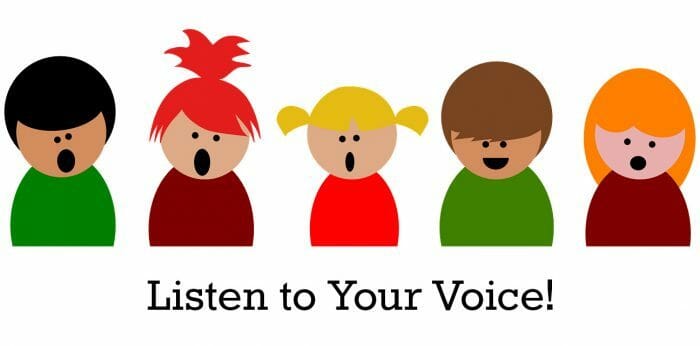Although it doesn’t feel that way for most of us, speaking with someone else is a complex activity. You have to be able to listen, interpret, and decide on a response, and then your brain coordinates what muscles need to move to say the sounds required to form the words. It is a lot of work using many different systems in the body! One of the subsystems that is necessary for us to produce speech is our voice box, or larynx. The larynx is home to the vocal folds, which not only help us speak but also protect our airway. It’s important to understand what the vocal folds do so we better understand why we need to listen to them.
Vocal folds sit in a pivotal position, just above our windpipe (trachea) and just in front of our food tube (esophagus). Vocal folds are the gatekeepers to our airway. They open the door when we breath air in but then slam that door shut when we swallow to keep food or saliva out of our lungs. For speaking, our vocal folds will come close enough together so that the air flowing between allows them to vibrate at an incredible rate (for children, this can be up to 300 cycles a second!) The faster our vocal folds vibrate, the higher our pitch. The more air the lungs push through our vocal folds and vocal tract, the greater our volume. So what can it mean if our voice does not have the right pitch, quality, or volume? Here are some ways that our voice communicates to us if it is unhealthy.
The most common voice disorder – especially in children – is vocal nodules.
Nodules are small calluses that form on the vocal folds after they have been abused or overused. It’s the same process for calluses forming on your feet – when you stress your skin with too much friction, it toughens up. Behaviors that place stress on your vocal folds include excessive yelling and screaming, making different noises (animal sounds, car noises, etc), excessive singing and speaking, and habitual throat clearing and coughing. These behaviors routinely slam our vocal folds together. Our vocal folds can also become swollen, making smooth vibrations more difficult. Swelling can occur due to dehydration, postnasal drip (often from allergies), poor posture and breath support, smoking, or even reflux. Nodules cause a raspy, scratchy voice with a low pitch that is easily fatigued. Not only does it affect speaking, but it can also cause pain if left untreated. If you are noticing these changes in your voice, determine if there are lifestyle habits that could be causing them.
What if your voice sounds wet or “gurgly”, especially after or during a meal? A wet voice tells us there is a substance sitting on top of the vocal folds, whether it is mucous, food, or saliva. Normally, we involuntarily cough to force these agents out of our airway. In this way, coughing is a great protective mechanism! However, a wet voice without a cough could mean that the vocal folds are not doing their job properly and substances are slipping into the lungs. The voice is a great tool in assessing the safety of a swallow, especially in adults and children with feeding disorders.
You know how I mentioned that our vocal folds open when we breathe air in? Sometimes, you can end up reversing this movement and this leads to something called vocal cord dysfunction. It is most common in athletes and those who commonly do aerobic exercises. Instead of opening the vocal folds as air flows in, the vocal folds close in an attempt to breathe harder. This action limits air going in and the individual ends up gasping for air. As you can imagine, vocal cord dysfunction is often confused with asthma. In order to fix it, all we need to do is retrain our vocal folds!
It’s good to remember that our vocal folds not only help us speak, but they play a significant role in swallowing and breathing, as well. Keeping them healthy is important! If you are worried about your voice, it is best to consult with a speech-language pathologist or ear, nose, and throat (ENT) specialist. And don’t forget, listen to your voice!
Marissa Habeshy, MS, CCC-SLP
Image Courtesy Pixabay/Title Added








